Royal wedding dresses: From Kate Middleton to Princess Diana, these are the best and worst
They’re the most anticipated gowns of all time, but what actually goes into designing a royal wedding dress? We take a look back at the best, worst, and everything in between.
Royals
Don't miss out on the headlines from Royals. Followed categories will be added to My News.
- Inside ‘insecure’ Beatrice’s wedding reception
- Forget Meghan, Beatrice could knock Kate off her royal pedestal
They’re the most anticipated wedding dresses of all time and guaranteed to be talked about for decades to come. So how does a of the royal bride actually select a wedding dress ahead of their big day?
From taking secret meetings with Vogue staff to paying homage to Botticelli, we take a look at some of the British royal family’s most iconic wedding dresses from the last century, and the secret design histories behind them.
QUEEN ELIZABETH, THE QUEEN MOTHER
After turning down two previous proposals, Lady Elizabeth Bowes-Lyon married Prince Albert, Duke of York – who would later become King George V – in 1923.
The bride wore a medieval-inspired gown designed by her mother-in-law’s dressmaker, Madame Handley-Seymour. The gown was made of ivory chiffon moire, embroidered with pearls and sewn with silver thread.
Elizabeth broke with tradition and wore a chaplet of leaves instead of a tiara, and following the wedding ceremony, she had her bouquet placed at the Tomb of the Unknown Soldier in memory of her late brother who died in World War I. The tradition has been observed by every royal bride since.
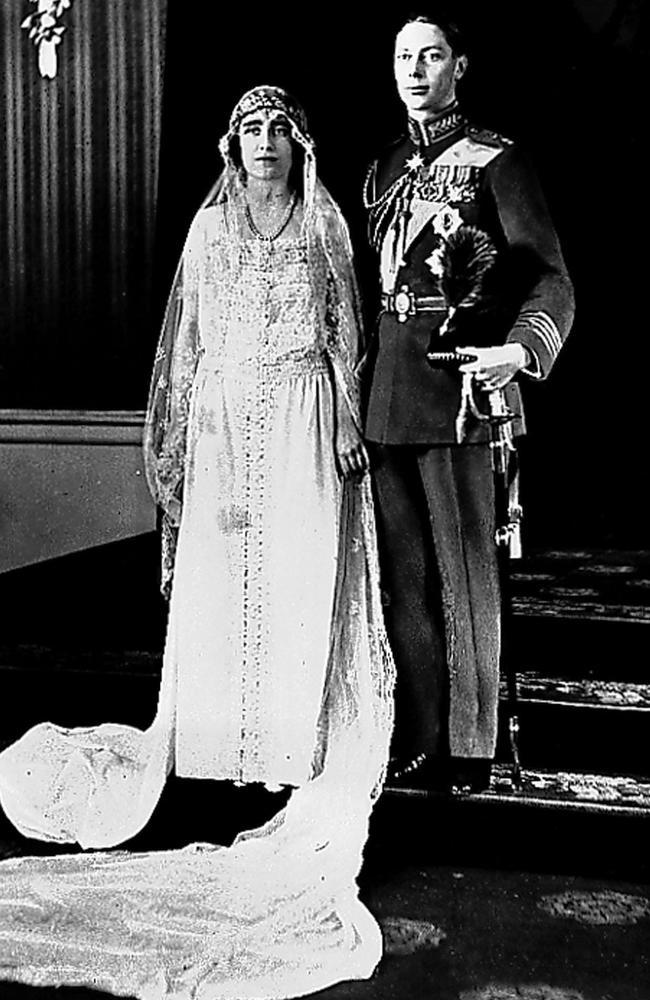
WALLIS, DUCHESS OF WINDSOR
The marriage of the twice-divorced Wallis Simpson and King Edward VIII not only triggered the abdication, but was also boycotted by the entire British royal family, with no one travelling to France to support or witness the couple’s nuptials.
The famously fashionable Simpson wore a blue tailored floor-length gown designed by Mainbocher. In lieu of a tiara she wore a Caroline Reboux straw hat that created “a halo effect”.
In 1950, the Duchess of Windsor donated her wedding dress to the Metropolitan Museum of Art in New York.

QUEEN ELIZABETH II
For her 1947 wedding to Prince Philip, Queen Elizabeth II enlisted the help of British designer Norman Hartnell, who based his design for the then Princess’s gown off Botticelli’s 1482 painting, Primavera, which represented rebirth and regeneration following World War II.
Hartnell and his team used thousands of crystals and pearls to embroider jasmine, lilac, roses, leaves and stars onto the Queen’s dress and four-metre-long silk train, and wore the diamond fringe tiara to secure her veil.
Due to post-war rationing, Queen Elizabeth II had to save coupons to justify her need for the dress, and brides-to-be from across the United Kingdom offered up their own coupons as an act of solidarity.

PRINCESS MARGARET
When it came time for the wedding of Princess Margaret to Antony Armstrong-Jones in 1960, Norman Hartnell was called upon again.
For the Queen’s younger sister, the designer chose a silk organza fabric, and used as little embellishment as possible, focusing his design on a fitted waist and full skirt.
The Princess wore the intricate Poltimore tiara to complement the understated gown and veil.
Following the wedding, Princess Margaret’s dress was been recognised as one of Hartnell’s greatest designs, with Vogue describing it as “stunningly tailored”.

PRINCESS ANNE
For her 1973 wedding to Captain Mark Phillips, Princess Anne took a note out of her aunt’s book and opted for understated elegance.
Created by British designer Maureen Baker, who had designed outfits for Princess Anne prior to the wedding, the silk gown’s high collar and medieval sleeves were distinctly Tudor-style, while the seven foot train and minimal embellishment modernised the look, which was later championed for its simplicity.
Princess Anne also opted to wear the fringe tiara, as her mother had previously done.
When marrying her second husband, Timothy Laurence in 1992, the Princess went even simpler, opting to wear a cropped white dress that sat at the knee, with a crepe jacket over the top.

DIANA, PRINCESS OF WALES
Princess Diana’s 1981 wedding gown is possibly the most famous dress of all time.
Designed by David and Elizabeth Emanuel, the silk taffeta and lace gown boasts hand embroidery, 10,000 pearls, sequins, an 18-carat gold horseshoe sewn into the petticoats for good fortune, and a 7.62 metre train, which was so long it almost didn’t fit in the carriage taking the bride to St Paul’s Cathedral to marry Prince Charles.
Princess Diana topped the look off with her family’s Spencer tiara and a veil consisting 153 yards of tulle.
The puffed sleeves, full skirt and lace trimmings set the tone and style for the 80s wedding dress.
Following the wedding, Emanuel described the challenge of designing something that “was going to go down in history, but was also something that Diana loved.”
Fears that the design would leak ahead of the wedding were so great that Princess Diana had a backup wedding dress made, but thankfully the secret was kept.

SARAH, DUCHESS OF YORK
Sarah Ferguson took a leaf out of her sister-in-law’s book for her 1986 wedding to Prince Andrew, opting for a heavily beaded ivory duchesse satin gown featuring fabric rosettes and artificial silk flowers.
Created by British designer Lindka Cierach, the wedding gown also included embroidered motifs of hearts, thistles, bumblebees, anchors and waves, and had the entwined letters ‘S’ and ‘A’ stitched onto the 17-foot-long train with silver beads.
In 1997, the Duchess of York admitted she’d lost almost 12 kilos to fit into the dress, which became the most popular wedding gown style of the year following her trip down the aisle.

SOPHIE, COUNTESS OF WESSEX
The interest in what Sophie Rhys-Jones would wear at her 1999 wedding to the Queen’s youngest son, Prince Edward, was so great that in the months leading up to the big day designer Samantha Shaw was forced to hire security to monitor her studio.
Speaking to Tatler in May, Shaw said, “A friend of mine managed to find me a security guard who he personally trusted to stay at my studio, as someone did go through my bins and was hanging around there at night! The invasion of my privacy was very daunting.”
The end result was worth the secrecy, though.
The coat dress was made of silk crepe and hand-dyed silk organza evening coat colour-matched to the stone of St George’s Chapel, and had a total of 325,000 glass and pearl beads sewn onto the V-neck dress.
Underneath, Shaw says, was a top-secret evening dress designed especially for the private reception that the public didn’t get to see.
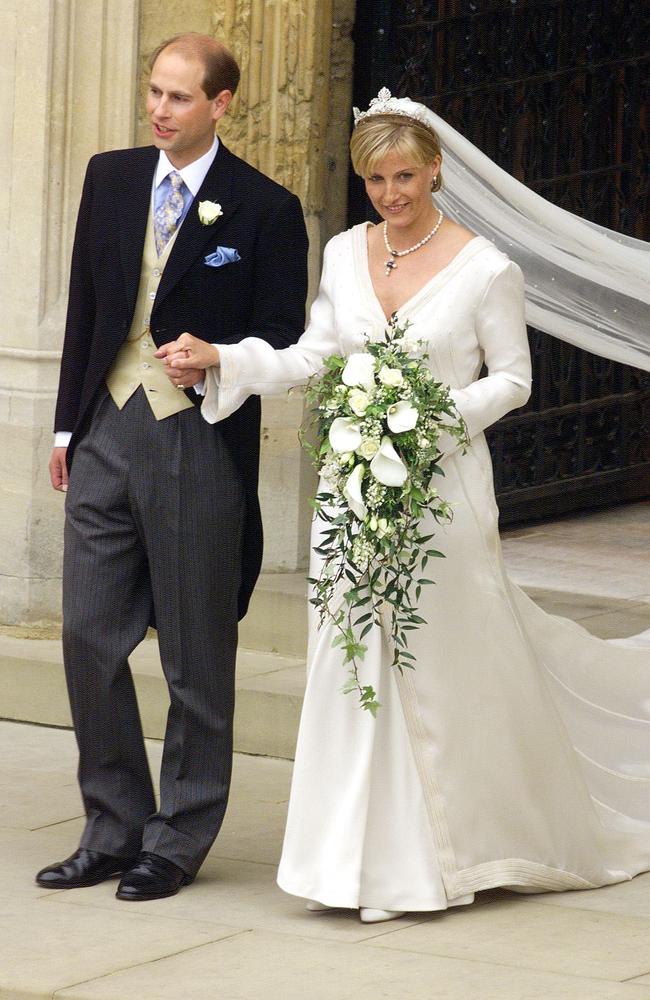
CAMILLA, DUCHESS OF CORNWALL
Despite being one of the most long-awaited marriages in royal history, the 2005 wedding of Prince Charles and Camilla Parker-Bowles was a distinctly understated affair.
For the wedding ceremony at Windsor Guildhall, the bride wore a cream silk chiffon mid-length dress and a silk basket weave coat paired with a Philip Treacy hat featuring French lace and feathers.

For the couple’s blessing, Parker-Bowles changed into a floor-length blue and gold coat dress paired with a gold feather headpiece.
Both outfits were designed by British artists Antonia Robinson and Anna Valentine, who explained the design brief was simply a “crisp clean look with subtle detailing.” Mission accomplished.

AUTUMN PHILLIPS
For her 2008 wedding to the Queen’s eldest grandson, Peter Phillips, Autumn Kelly tasked British designer Sassi Holford with designing her gown.
The result was a classic silk duchesse skirt, fitted bodice, French lace shoulders, and large bows covering the back of the skirt. The bride also wore the Festoon tiara, which was loaned to her by her mother-in-law, Princess Anne.
Phillips was the first of the Queen’s grandchildren to marry. Sadly, the couple announced in February that they separated last year.
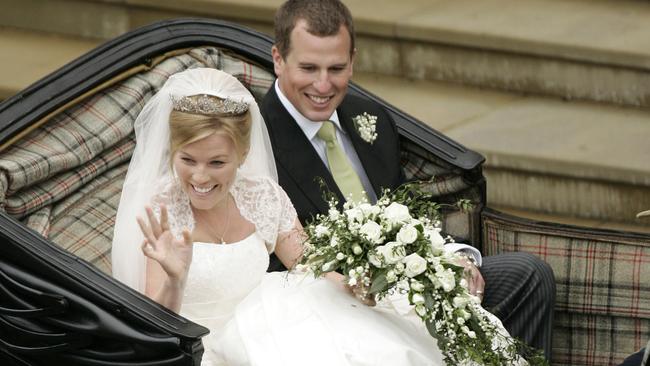
CATHERINE, DUCHESS OF CAMBRIDGE
Much like her late mother-in-law, the wedding dress of Kate Middleton was hotly anticipated and heavily speculated upon in the months leading up to her April 2011 wedding to Prince William.
Designed by Alexander McQueen creative director Sarah Burton, the Victorian-inspired long-sleeve silk and lace dress was championed for its timeless elegance, and has been credited with influencing the next decade of wedding dress trends.
In selecting a designer, Middleton called upon the advice of then British Vogue Editor-in-Chief Alexandra Shulman.
Speaking to Hello Magazine earlier this year, Shulman said, “It was clear that the chosen name should be British, but it was less clear whether it should be a fashion designer or somebody who specialised in bridal wear.”

“As we talked I began to realise that my favourite was Alexander McQueen, a label which at that point, shortly after McQueen’s horribly untimely death [McQueen died by suicide in 2010], was newly in the hands of Sarah Burton. I thought that the level of extraordinary craftsmanship and their tradition of working with symbolism would be up to the task, that Sarah and Catherine would get on as women, and that it would be terrific to have a relatively untraditional fashion house given this privilege.”
For her something borrowed, Middleton wore the Queen’s Halo tiara, before slipping into a strapless satin gown (also designed by Burton) for the couple’s evening reception.

ZARA TINDALL
Heading down the aisle just months after her cousin, Zara Phillips’ 2011 wedding to rugby player Mike Tindall was devoid of much and the pomp and ceremony that Prince William and Kate Middleton had been forced to endure.
Marrying at Edinburgh’s Canongate Kirk, the Eventing World Champion wore an ivory silk and satin gown by designer Stewart Parvin, and secured her veil in place with her mother’s Greek Key Diamond tiara.

MEGHAN, DUCHESS OF SUSSEX
Following her sister-in-law’s tradition, Meghan Markle also chose a female British designer to create the dress for her 2018 wedding to Prince Harry.
In selecting Clare Waight Keller, the creative director of French fashion house Givenchy, Markle said she “wanted to highlight the success of a leading British talent,” and said Waight Keller’s “elegant aesthetic” and “relaxed demeanour” appealed to her.
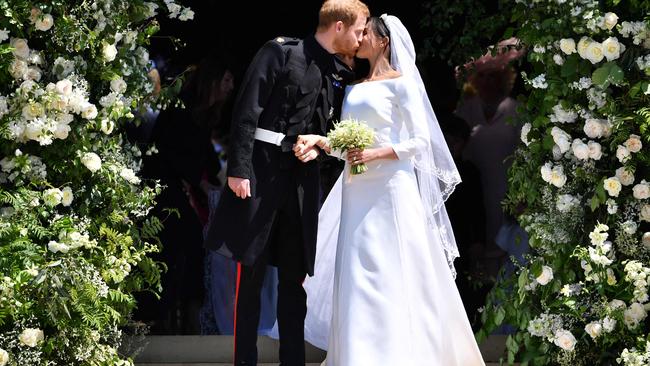
The silk dress consisted of three quarter length sleeves, an elegant boat neckline and an intricate 16 – foot-long veil which was hand embroidered with flowers representing the 53 countries of the Commonwealth, as well as the California poppy to symbolise Markle’s home town, and wintersweet, a flower that grows outside the couple’s Kensington Palace home of Nottingham Cottage.
The veil reportedly took 500 hours to complete and required embroiders to wash their hands every 30 minutes to ensure it remained white, and was held in place by the Queen’s diamond bandeau tiara.
For the couple’s evening reception, the Duchess of Sussex opted for a relaxed high-necked Stella McCartney evening gown made of white silk crepe.

PRINCESS EUGENIE
The youngest of Prince Andrew’s daughters broke with royal tradition on her 2018 wedding day to Jack Brooksbank when she headed down the aisle with no veil.
The decision, however, was a conscious one, as Princess Eugenie wanted to show the spinal scar she acquired as a child when undergoing a scoliosis operation. The Princess explained the decision, saying “scars tell a story about your past and your future,” and the aim in showing her scar was “getting rid of a taboo”.
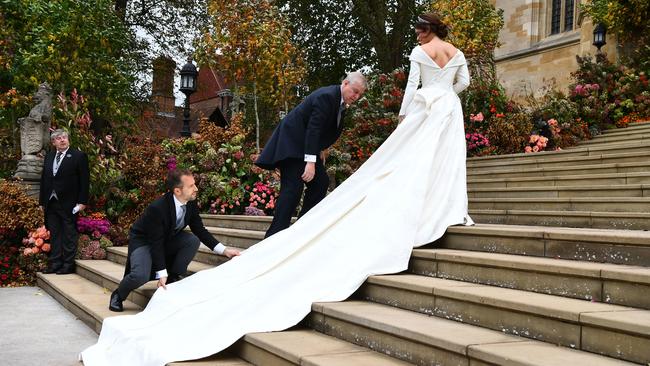
Designers Peter Pilotto and Christopher De Vos honoured the 28-year-old bride’s wishes by designing a long-sleeved, low back gown with a full pleated skirt made of a custom-woven silk, cotton and viscose blend fabric that bore four symbols unique to the couple: the thistle of Scotland to honour their love for the Queen’s Balmoral Estate, a shamrock to honour the bride’s Irish mother, the York rose as a nod to Eugenie’s father, and ivy, which grows at the couple’s shared home.
The Princess also wore her Grandmother’s Emerald Kokoshnik tiara to the ceremony.
Later, Beatrice changed into a custom Zac Posen evening gown for the reception, which she says was inspired by Grace Kelly’s character in To Catch a Thief.

PRINCESS BEATRICE
For her Friday wedding to Italian property developer Edoardo Mapelli Mozzi, Princess Beatrice took the adage of ‘something old, something new, something borrowed, something blue’ to another level.
For the ceremony at All Saint’s Chapel in Windsor Park, which was attended by just 20 people due to coronavirus restrictions, Beatrice borrowed a Norman Hartnell dress designed for the Queen in 1962, as well as her grandmother’s diamond fringe tiara.
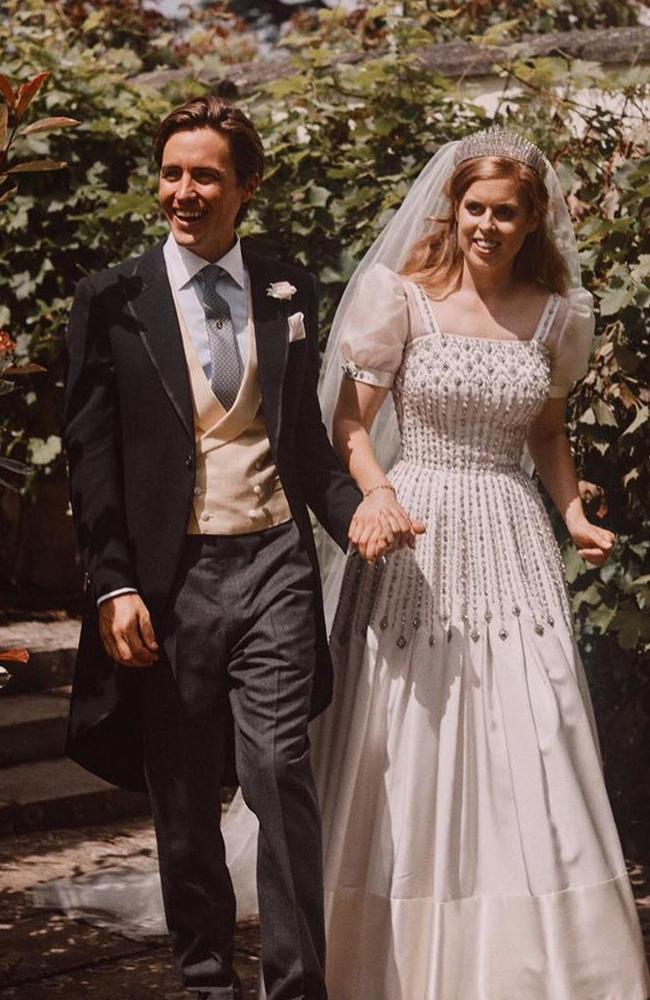
Prior to the top-secret ceremony the Queen’s dressmaker altered the gown to include sleeves, add diamonds to the bodice, and shorten the hemline.
Princess Beatrice also upcycled a pair of high heels she’d previously worn to the wedding of her cousin, Prince William to Kate Middleton. Talk about thrifty!
Originally published as Royal wedding dresses: From Kate Middleton to Princess Diana, these are the best and worst
